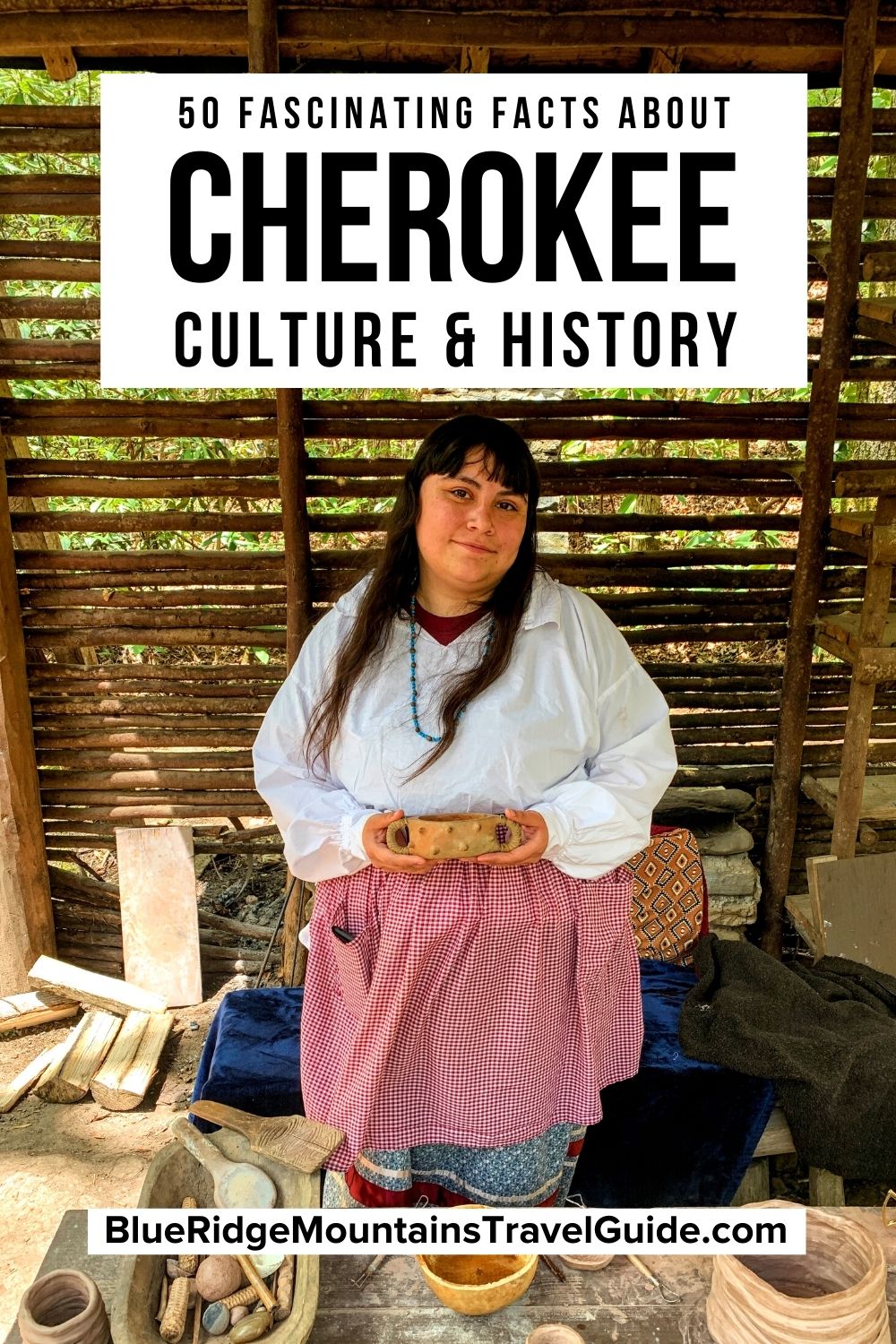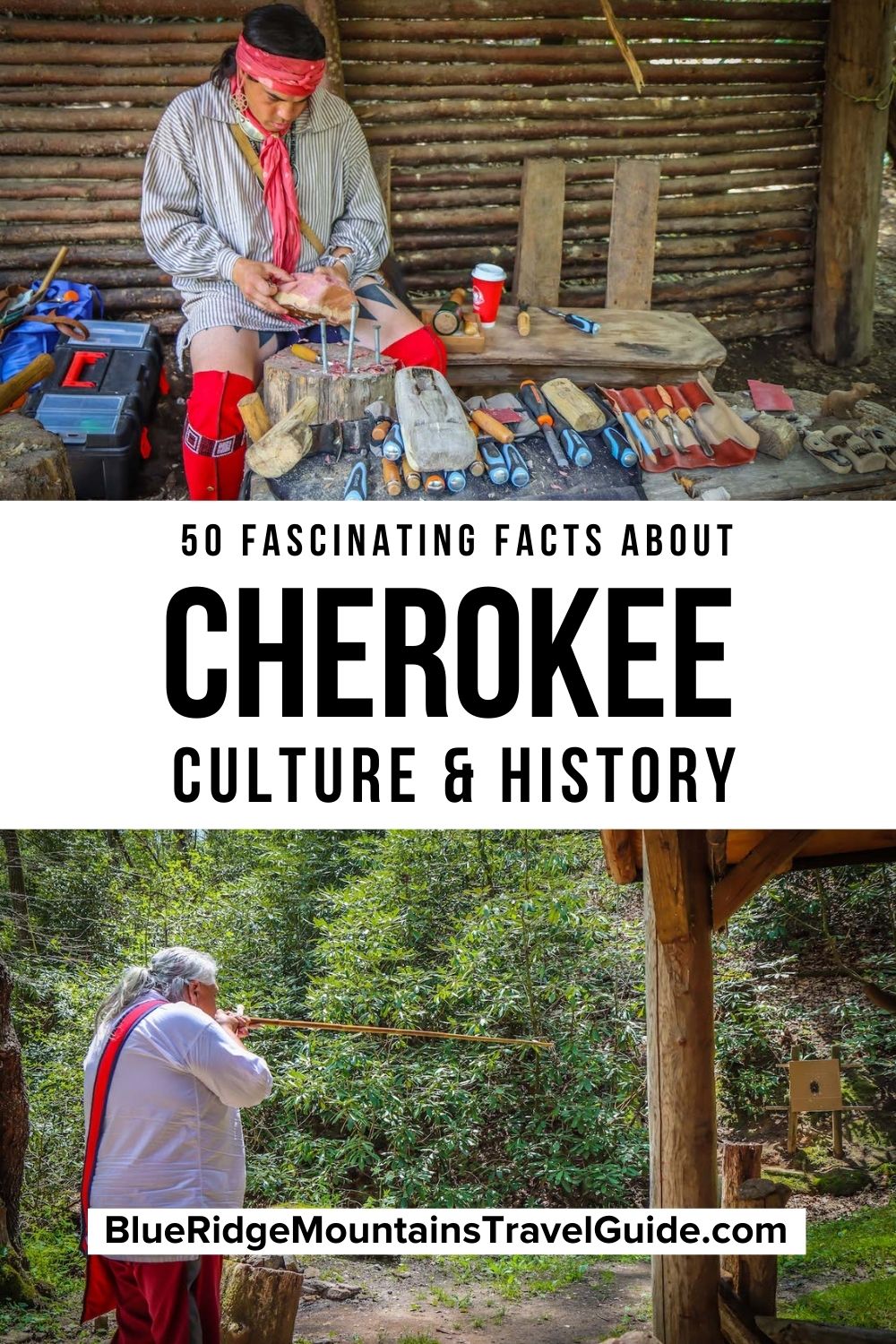[Updated 5/27/2022] Before Europeans settlers began spreading throughout the southeastern United States, the Cherokee were the dominant Native American tribe in the Blue Ridge Mountains for centuries.
Cultivating a rich culture of spirituality, storytelling, language, art, and a deep respect for the Earth, the Cherokee people thrived well into the late 18h century.
By the early 19th century, conflicts between European immigrants and America’s indigenous people threatened the Cherokee tribe’s survival, and eventually forced them from their ancestral lands in the tragic Trail of Tears.
Despite a history filled with trials and trauma, the resilience of the Cherokee people has allowed them to remain prominent today.
With more than 300,000 tribal members dedicated to preserving their rich cultural heritage and history, the Cherokee Nation is the largest of the 567 federally recognized tribes in the US.
Read on to learn 50 fascinating facts about Cherokee culture and history, from their ancient origin in the Great Lakes to the founding of their capital at New Echota, the Trail of Tears, and the present day.
READ MORE: Exploring the Dark History of the New Echota Historic Site in Calhoun GA
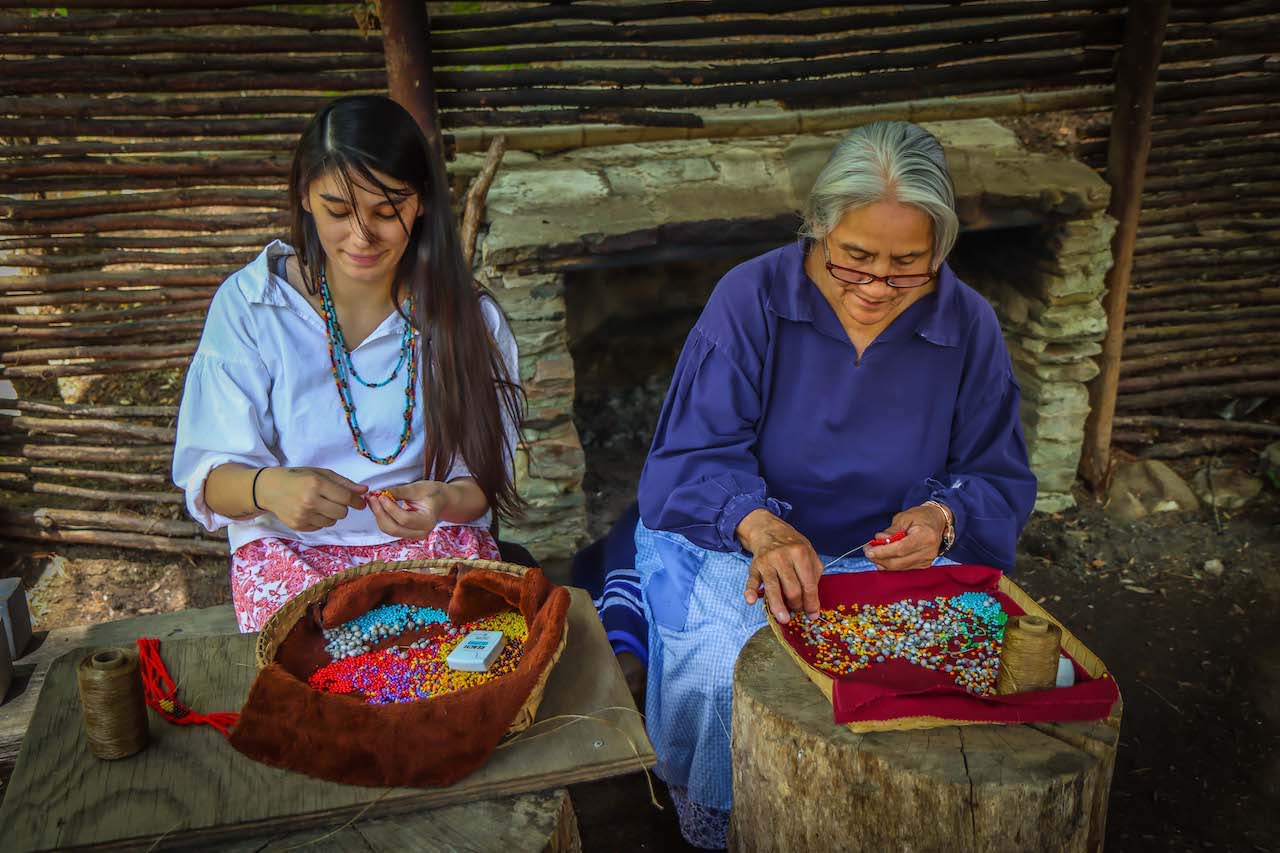
Facts About Cherokee Culture & History Guide
- General Facts About Cherokee Culture
- Cherokee Religion
- Cherokee Food
- History of Cherokee in Georgia (pre-Trail of Tears)
- History of Cherokee in North Carolina (pre-Trail of Tears)
- Sequoyah & The Cherokee Language
- The Trail of Tears in Georgia & North Carolina
- Cherokee Culture & Cherokee Traditions Today
- Cherokee Landmarks in the Blue Ridge Region
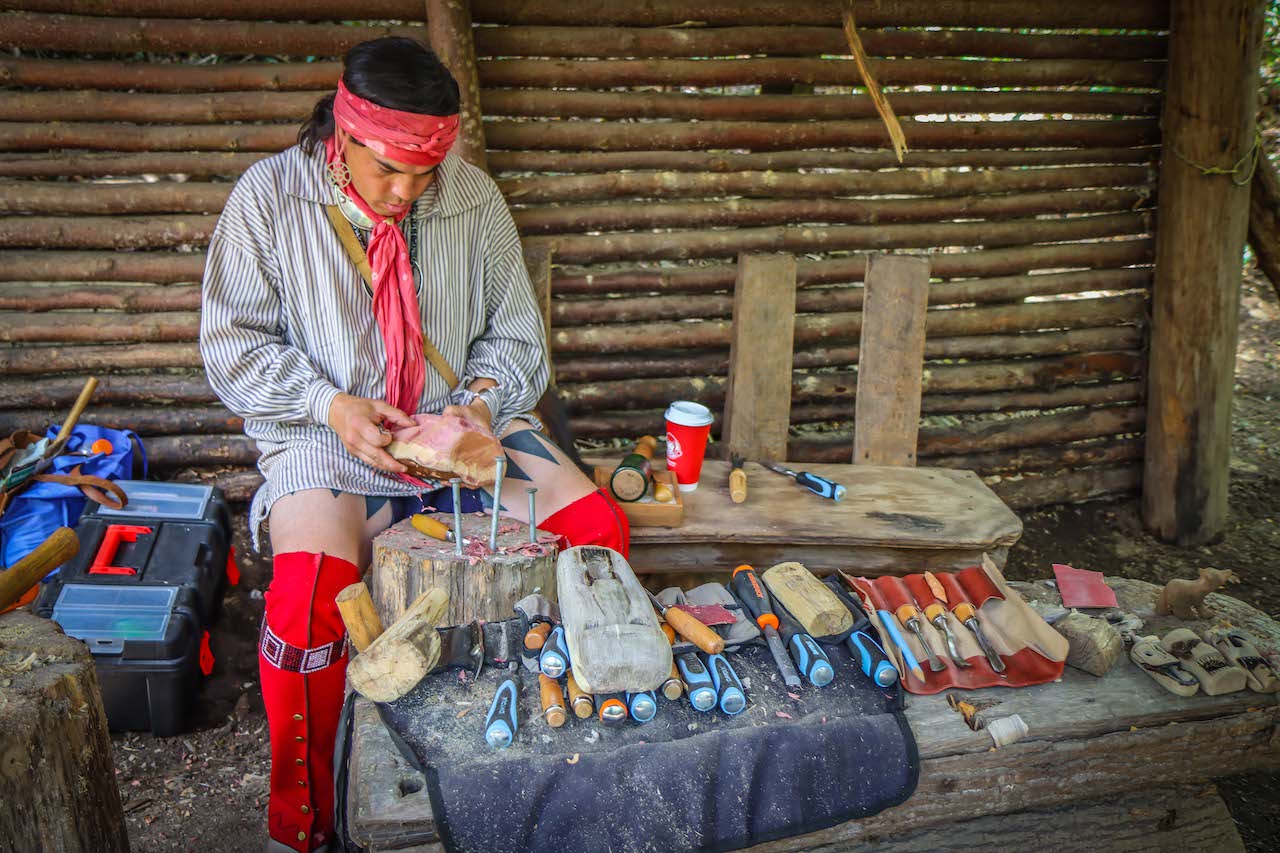
General Facts About Cherokee Culture
1. The Cherokee people are an Iroquian-speaking people who refer to themselves as Aniyvwiya (“the Real People”). Most Iroquoian-speaking people lived near the Great Lakes, leading historians to believe the Cherokee migrated south from that region. They eventually settled in the mountains of North Georgia, eastern Tennessee, and Western North Carolina.
2. Cherokee villages were usually positioned near a river and consisted of 30 to 60 houses, as well as a larger council house used for political assemblies and religious ceremonies. These houses were made out of river cane plastered with mud and had a thatched roof. After the arrival of European settlers, they began living in log cabins and wooden houses.
3. The Cherokee originally traveled on foot or via canoes made from hollowing out large logs. It wasn’t until Europeans came to the U.S. and brought horses that horseback riding became a common mode of transportation.
4. Cherokee men and women had distinct roles. Men were in charge of hunting, fighting, and making political decisions, while women were in charge of farming, property, taking care of the family, and making social decisions for the clan.
While only men could become war chiefs, women were the landowners in Cherokee culture. Since they were traditionally a matrilineal kinship society, all property and social status descended through the women’s line.
5. Cherokee men originally wore breechcloths and leggings made from deer hide, and would shave their heads, leaving just a long scalp-lock. Cherokee women kept their hair long and wore deerskin skirts and dresses, with moccasins on their feet. When cloth was later introduced by the Europeans, cotton blouses and skirts became more popular.
READ MORE: Exploring Oconaluftee Indian Village & Visitor Center in Cherokee NC
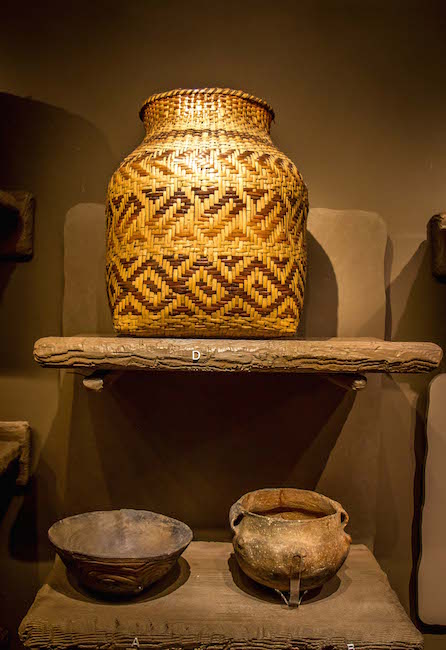
6. Traditional Cherokee arts included river cane basket weaving, gourd art, pottery, and pipe carving. After being forced out of their native lands and into Oklahoma, the tribe couldn’t find the materials they once used for art. So they began creating crafts such as intricate beadwork and textiles (rugs, blankets, quilts, etc.).
7. Music plays a significant role in Cherokee culture, and is performed for a variety of different functions. These include religious and healing ceremonies, storytelling, showing gratitude to the Earth, and to bring about bountiful harvests. Handmade drums, rattles, and flutes are common instruments that are played alongside singing and chanting.
8. Many Cherokee songs accompany dances for social or ceremonial purposes. They’re often performed in elaborate costumes, such as in the Bear Dance, Beaver Dance, and Eagle Dance, wherein masks of the animals are worn. The most important ceremonial Cherokee dance is the Stomp Dance, which is preceded by a game of Anejodi, or stickball.
READ MORE: The 15 Best Things to Do in Cherokee NC & the Qualla Boundary
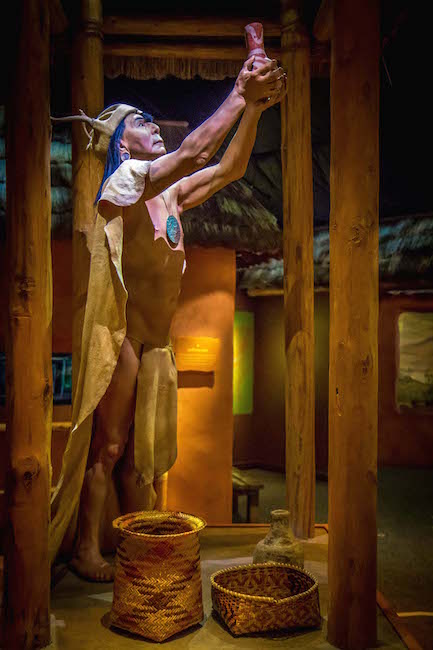
Cherokee Religion
9. Cherokee people regarded the spiritual and physical world as one and the same, believing that plants, animals, rivers, and mountains had spiritual powers. Rather than trying to rule over nature, the tribe believed it was their duty to be environmental stewards in order to maintain the Earth’s balance and harmony.
10. The basis of Cherokee religion was the belief that the universe is composed of three connected worlds– the Upper World, Middle World, and Under World.
The Middle World was thought to be where all living beings and spirits resided; the Upper World was where spirits of ancestors and animals that had passed on lived; and the Under World was where bad spirits lived.
Cherokee people believed that spirits from the Under World could come into the Middle World and cause disharmony. But spirits from the Upper World could also come down to restore balance if called on or needed.
READ MORE: The Appalachian Culture & History of the Blue Ridge Mountains

11. Special ceremonies were performed in order to ask the spirits for help in the Middle World before going to war, leaving on a hunt, or to help heal the sick. Ritual purification was also important to the Cherokee for maintaining spiritual balance.
A baptism-like ritual called “going to water” was often performed, wherein tribe members would be led by a medicine man (a.k.a. shaman) to a stream and immerse themselves to represent a rebirth.
12. The core belief in maintaining balance and harmony was upheld throughout myriad aspects of Cherokee society.
For example, when hunting and gathering, the Cherokee made sure to only take what was needed. They believed that if they killed too many plants or animals, they would disrupt the balance of nature.
Hunters would often take part in rituals before going out on a hunt, and after killing an animal they would typically ask for forgiveness.
READ MORE: The Cataloochee Valley Elk in Great Smoky Mountains National Park

Cherokee Food
13. The Cherokee people were hunters, gatherers, and farmers. Men would fish and hunt for wild hog, turkey, white-tailed deer, squirrel, and rabbit, while women foraged for wild plants, onions, mushrooms, and berries.
Women were also the primary gardeners and grew crops like squash, corn, and beans. These were known as the “Three Sisters,” because they grew well together and were used in almost all of their meals.
14. When hunting for deer, turkey, and other large game, the men would primarily use bows and arrows made from hickory and black locust trees, with flint-knapped arrowheads.
For smaller game like squirrels and rabbits, they would use blowguns made from river cane.
Traditionally, the Cherokee would only hunt out of necessity to feed their families. But when European settlers introduced firearms, they began to hunt for trade as well.
15. The arrival of the Europeans also changed Cherokee farming practices, as they began growing peaches and watermelons with seeds acquired through trade.
They also started growing apples from Europe, sweet potatoes from the Caribbean, and black-eyed peas from Africa.
READ MORE: The Best Downtown Asheville Restaurants
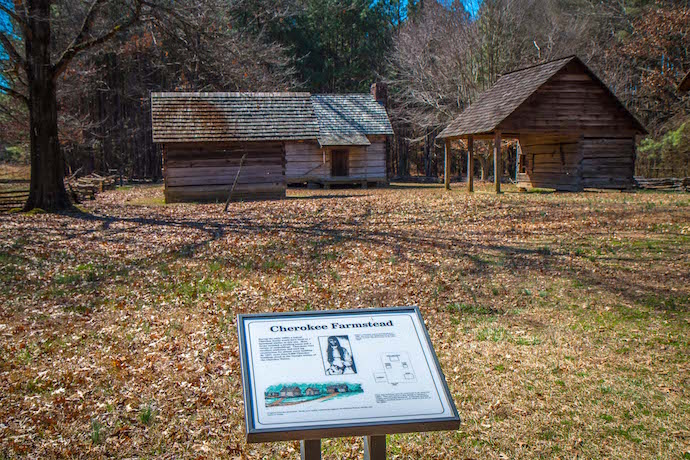
History of Cherokee in Georgia (pre-Trail of Tears)
16. Cherokee people inhabited the Southeastern US– including parts of present-day Alabama, Tennessee, North Carolina, South Carolina, and North Georgia– for countless generations before the arrival of Europeans.
17. Europeans first came in contact with the Cherokee during the 1540 Spanish expedition of Hernando de Soto.
The famed conquistador passed through what is now Embreeville, Tennessee, and eventually made his way through Cherokee villages in Georgia while searching for gold.
After the Europeans arrived, the Cherokee population began to drastically decline, in large part due to introduced diseases to which the Native Americans had no immunity.
18. When the state of Georgia was founded in 1733, the Cherokee became key trading partners of the British in Augusta.
European manufactured goods like weapons and tools were traded for beeswax, river cane baskets, and deerskins.
As trade increased, the Brits began living in Cherokee villages, and peace treaties between the two cultures were created.
They included a promise by the natives to the British Crown in 1730 to only trade with Englishmen.
READ MORE: Appalachian Folklore, Monsters and Superstitions

19. During the Seven Years’ War (a.k.a. the French & Indian War), the Cherokee/England alliance was tested.
The Native Americans initially joined the British war effort against France. But after feeling undervalued for their services, skirmishes ensued, which eventually led to full warfare between them.
The Cherokee began attacking southern colonies. The British retaliated with two military incursions during the Anglo-Cherokee War (1758-1761), which caused widespread destruction of Cherokee towns in Georgia and South Carolina.
20. After the murder of a number of Cherokee leaders in the State of Franklin (now East Tennessee), Little Turkey was elected as chief of the Cherokee.
The seat of the Cherokee council was then moved from Chota to Ustanali (later known as New Echota, in Calhoun GA), which was established by refugees from the Cherokee Lower Towns.
21. The government of the Cherokee Nation began meeting in New Echota. On November 12, 1825, it was officially named their capital, serving as a place for Cherokee Council meetings, court hearings, and social gatherings.
New Echota was the site of the first Cherokee newspaper (the Cherokee Phoenix), their first Supreme Courthouse, and, most infamously, where the Treaty of New Echota was signed ceding Cherokee land to the U.S.
22. After the Cherokee were removed from North Georgia during the Trail of Tears in 1838, their capital was abandoned for over 100 years.
In 1954, a team of archeologists began excavating New Echota. They uncovered thousands artifacts from the Cherokee era as well as relics of earlier indigenous cultures.
As a result, the State of Georgia authorized reconstruction of New Echota, including important buildings like the Council House and Supreme Court. The New Echota Historical Park was officially opened in 1962.
READ MORE: The 15 Best North Georgia State Parks & Historic Sites
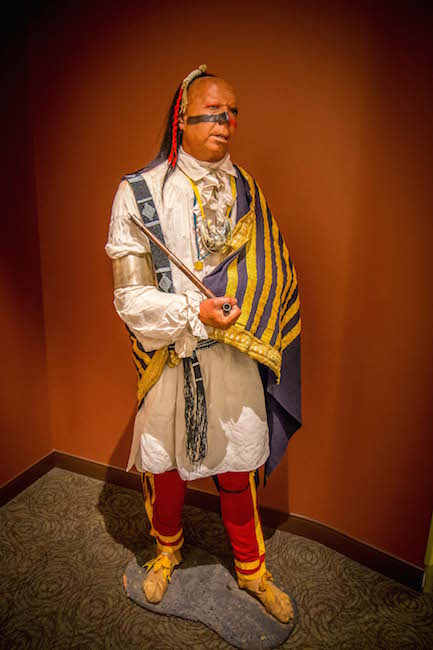
History of Cherokee in North Carolina (pre-Trail of Tears)
23. In western North Carolina, the Cherokee inhabited what were known as the Valley, Middle, and Outer Towns.
They were located along the major rivers of the Tuckasegee, the upper Little Tennessee, and French Broad River.
24. After Hernando De Soto made initial contact with the Cherokee in 1540, an expedition led by Juan Pardo in 1566 further explored Cherokee land in western North Carolina and southeastern Tennessee.
Pardo stayed at the Joara chiefdom near Morganton, North Carolina, and explored Cherokee villages near Asheville.
25. During the Revolutionary War, the Cherokee aligned themselves with the British. They hoped that, if the British won, they would stop colonial expansion to the west (just as they’d done with the Royal Proclamation of 1763).
Unfortunately, when the British were defeated, the Cherokee people lost a large portion of their North Carolina land to the newly formed United States of America.
26. In 1798, the Tellico Treaty was signed in response to the influx of settlers into North Carolina’s Cherokee territory.
This treaty required that the Meigs-Freeman line be drawn to stop more settlers from encroaching on Cherokee land.
This line went from the peak of Mount Collins to a spot on the North Carolina-South Carolina border, near what is now Brevard NC.
READ MORE: Hickory Ridge Living History Museum & Horn in the West in Boone NC
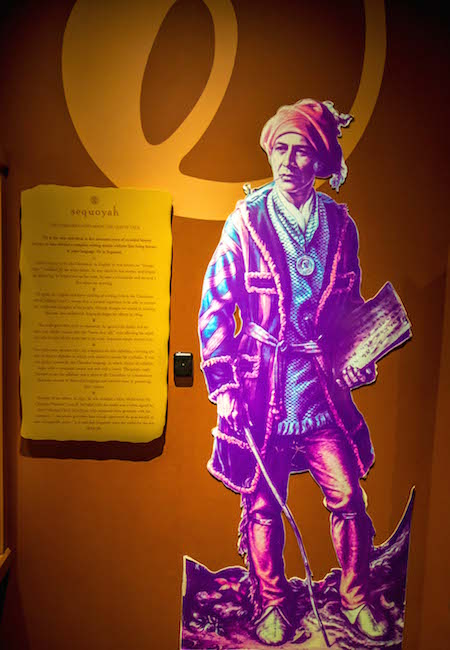
Sequoyah & The Cherokee Language
27. Sequoyah was a Cherokee man who served in the U.S. Army in the Creek War, and was also an accomplished silversmith and painter.
As a silversmith, Sequoyah interacted with many European Americans. He was especially impressed by their writing, believing that the ability to record and transmit knowledge held a considerable amount of power.
28. By 1809, Sequoyah began attempting to create a system of writing for the Cherokee language.
He started by trying to create a pictograph system, wherein every word in the language had a character or symbol. But he ultimately found it to be impractical.
Eventually he isolated 85 distinct syllables in Cherokee speech, and assigned each one a symbol. For reference on how to shape the different letters, he used a printed Bible.
29. Sequoyah’s 6-year-old daughter, Ayokeh, helped complete his work and was the first to learn the new syllabary.
They were both charged with witchcraft and brought to trial, wherein they were separated and asked to exchange messages in order to see if their new Cherokee syllabary actually worked.
After proving it did, the warriors presiding over the trial deemed Sequoyah’s syllabary legitimate.
READ MORE: The 15 Best Historic Sites in Georgia
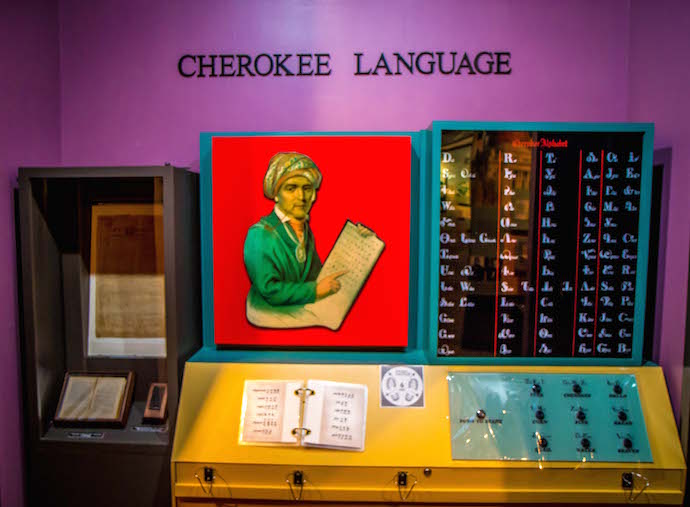
30. Because the syllabary was based on sounds unique to their language, it was not difficult for the Cherokee people to learn. Over the next few years, the majority of the Cherokee population became literate.
Sequoyah’s syllabary was officially adopted in 1825, making the Cherokee Nation one of the world’s first indigenous groups to have their own effective written language.
31. The syllabary proved to be incredibly useful, and spurred the creation of the first Cherokee newspaper, the Cherokee Phoenix.
Chief writer Elias Boudinot wrote in both English and Cherokee, using the syllabary created by Sequoyah. The newspaper quickly became the primary method of communication among the Cherokee Nation.
32. Today Sequoyah is remembered as one of the most influential people in Cherokee history. There is a monument honoring him in Calhoun GA, as well as a 22-foot tall wooden bust of him outside of North Carolina’s Museum of the Cherokee Indian honoring his remarkable legacy.
READ MORE: The Top 20 Blue Ridge Mountain Towns in GA & NC

The Trail of Tears in Georgia & North Carolina
33. The Trail of Tears was the forced relocation of nearly 100,000 Native Americans from their ancestral homeland to “Indian Territory” in Oklahoma after President Andrew Jackson signed the Indian Removal Act in 1830.
This law allowed the federal government to exchange land and negotiate removal treaties with Native Americans. They were supposed to do it fairly, but the negotiations eventually became more forceful.
34. The Cherokee people were divided. The majority, led by nationalist John Ross, wanted to fight for their land. A vocal minority, led by Major Ridge and his son John, believed it was better to to leave in exchange for money and other assets.
In 1835, the “Ridgeites” signed the Treaty of New Echota, which gave the Cherokee tribe $5 million and a chunk of land in Oklahoma in exchange for their ancestral lands. They were later killed by their own people as traitors.
READ MORE: How Gold Mining in Georgia Led to Land Lotteries & the Trail of Tears

35. Recognizing a lack of community support, the US government allowed a two-year extension to give Cherokee people time to move. By 1838, around 2,000 Cherokee had moved voluntarily. So the government sent 7,000 soldiers (led by Winfield Scott) to force them out, marching them to the new Indian Territory.
36. The brutal trek– over 1,000 miles through rough terrain and terrible weather– was made mostly on foot. Sickness ran rampant, with whooping cough, typhus, dysentery, cholera, and starvation striking down many Cherokee along the way. It’s estimated that some 4,000 Cherokee died during the tragic Trail of Tears relocation process.
37. Today the journey is commemorated by the Trail of Tears National Historic Trail, which stretches across nine states and retraces the route to Tahlequah OK. There’s also a Trail of Tears Highway that runs through the tiny town of Summerville GA. It traces part of the original route, with historical markers along the way.
READ MORE: 30 Fascinating Facts About the Appalachian Mountains for Trivia Buffs

Cherokee Culture & Cherokee Traditions Today
38. Today there are three federally recognized Cherokee tribes: the Eastern Band of Cherokee Indians in North Carolina, the United Keetoowah Band of Cherokee Indians in Oklahoma, and the Cherokee Nation in Oklahoma. It is the largest tribal nation in the US, with over 300,000 citizens.
39. The Cherokee language is the only southern Iroquoian language still spoken today. An estimated 2,000 people are fluent, with several thousand others considered proficient speakers. Some NGOs are taking steps to ensure the preservation of the language, including the Cherokee Preservation Foundation.
40. The Cherokee Nation observes an annual holiday on September 6, commemorating the signing of the Cherokee Nation Constitution in 1839. The celebration takes place in Tahlequah OK, and draws 100,000+ visitors. There’s a parade through downtown Tahlequah, traditional games, concerts, and arts & crafts as well as the Chief’s State of the Nation Address.
41. There are also a number of cultural festivals celebrating Cherokee customs that take place throughout the year. These include the Cherokee Voices Festival in Cherokee NC, the Northern Cherokee Nation Annual Powwow & Cultural Gathering in Clinton MO, and the annual 4th of July Powwow & Fireworks in Cherokee NC.
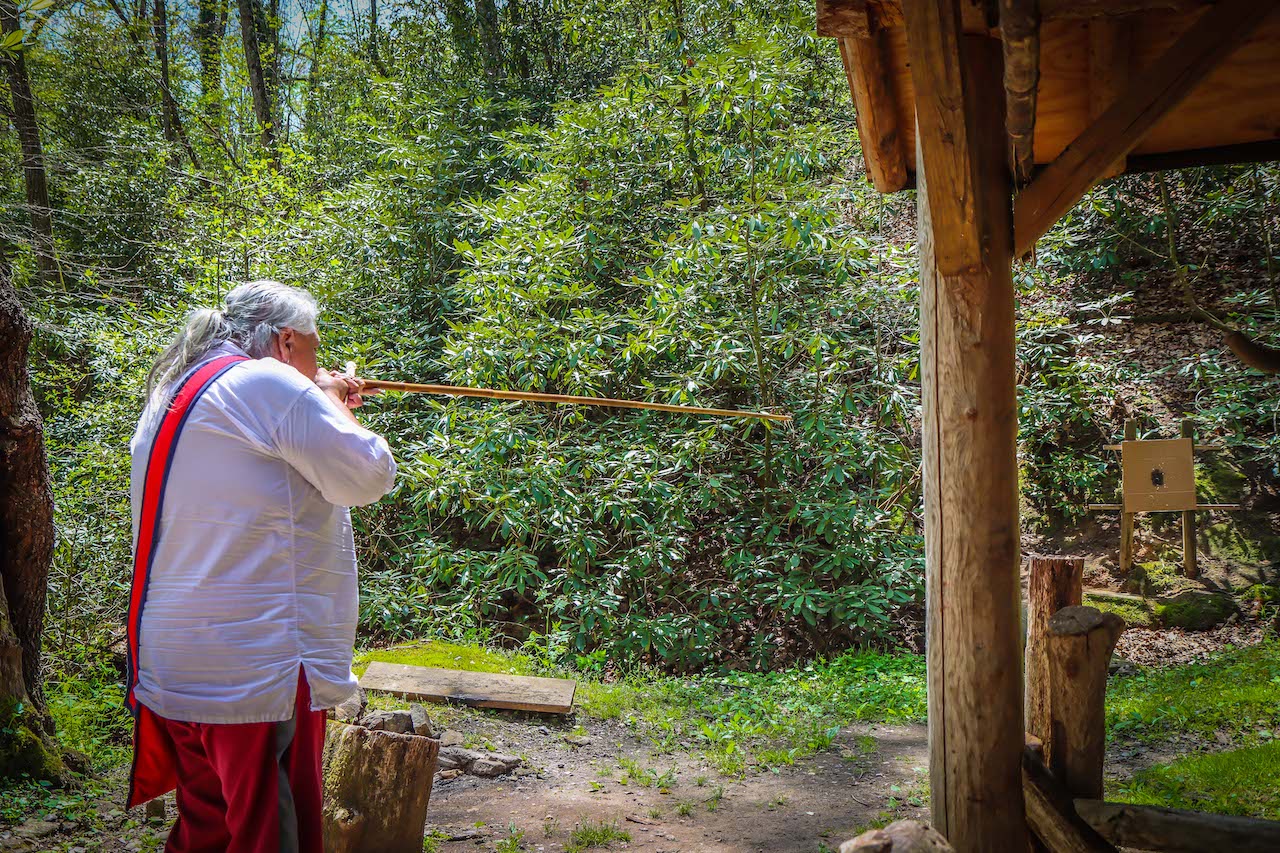
42. The Cherokee National seal was created in 1869. It contains a 7-pointed star (representing the 7 Cherokee clans) inside a wreath of oak leaves. The words “Cherokee Nation, September 6, 1839” are included to recognize the date the first Cherokee Nation Constitution was signed after relocation to Indian Territory.
43. The Cherokee Flag was designed by Stanley John and approved by the Cherokee Tribal Council on October 9, 1978. It contains the Cherokee Nation seal surrounded by 7 stars. There’s an additional star in the upper right-hand corner, which is black in remembrance of those who died on the Trail of Tears.
44. Although the origins of some of the oldest Cherokee games have been lost through time, many were originally created as a way to teach valuable skills, such as accuracy for hunting. Examples include blowgun contests, cornstalk shoots, and a sport called chunkey where players throw spears at a rolling stone.
45. While Cherokee foods have changed over time, many are still enjoyed during special occasions. Traditional favorites include wild onions cooked with eggs, cornmeal-dredged fried crawdads, fried hog meat, fried fish, poke sallet and watercress, and desserts such as grape dumplings and kanutsi.
READ MORE: Exploring Chickamauga and Chattanooga National Military Park in Lookout Mountain

Cherokee Landmarks in the Blue Ridge Region
46. From 1000 to 1550 A.D, the Etowah Indian Mounds were home to thousands of Native Americans. They were first inhabited by the Mississippian people, then the Muscogee Creek, and finally the Cherokee. The 54-acre site features the largest Indian mounds in Georgia, and was recognized as a National Historic Landmark in 1964.
47. Known as one of the most important indigenous sites in the US, the New Echota Historic Site in Calhoun GA is vital in preserving Cherokee history. The site has 12 Cherokee buildings that include the Court House, Council House, Print Shop, an Inn, and private homes. There are also historic hiking trails and a museum with interpretive exhibits.
48. In the 1790s, Cherokee Chief James Vann established the largest plantation in the Cherokee Nation. In 1804, he built a large brick home. After his murder in 1809, his son Joseph inherited the property, but the family lost their home during the Trail of Tears. Today, the Chief Vann House in Chatsworth GA is one of the best-preserved historic Cherokee homes.
49. The Chieftains Museum/Major Ridge Home in Rome GA is a two-story cabin that was once the home of Cherokee leader Major Ridge and his family. Now a a National Historic Landmark, the house was transformed into a museum in 1971, featuring interpretive exhibits, educational programs, and special events focused on Cherokee history and culture.
50. The Oconaluftee Indian Village in Cherokee NC is a living history museum that replicates an 18th-century eastern Cherokee community. The village has traditional Cherokee cabins and other buildings, with interpreters offering lectures on Cherokee culture and history, creating traditional crafts, and more. –by Christina Maggitas; all photos by Bret Love & Mary Gabbett


